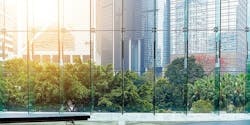Do you feel safe at your facility? If you avoid the darkest parts of your parking garage at night or notice an increase in vandalism or littering on your property, your security practices could probably use an overhaul. Implement these effective access control and security tips below.
Fortunately, that doesn’t always mean a suite of expensive new cameras. It could be as simple as integrating the principles of Crime Prevention through Environmental Design (CPTED), a layered approach that emphasizes barrier-free observation, easy access control and clear boundary marking in addition to the same upkeep you’re probably already doing.
Any site or building type can benefit from integrating the principles of CPTED. Familiarize yourself with the tenets of this common-sense design philosophy and learn how to spot red flags at your building.
CPTED Basics
CPTED is a layered approach combining four principles: natural surveillance, natural access control, territorial reinforcement and maintenance. All four work together to create an environment that both makes potential criminals uncomfortable and enables occupants to notice anything out of place.
“CPTED is essentially the premise that people with malevolent intent want to be clandestine and don’t want to be detected or observed,” explains Sean Ahrens, security market group leader for Affiliated Engineers. “We can change the built environment to make them more observable, thereby creating fear that they’ll be caught either during the incident or afterward.”
BUILDINGS Podcast
Security Threats of Tailgating in Your Facility
[podcast]
Sean Ahrens, a leader in the field of security and resilience, as well as a project manager for Affiliated Engineers, Inc., shares insights with Janelle Penny into the security threats of tailgating and piggybacking in respect to the access control of your building.
Rather read the transcript? Do so here: Tips to Eliminate Tailgating Risks in Your Building
The layered principles follow the flow of foot traffic, from designated paths onto and through the site to the layout of the building interior.
“Orient workstations so you can look out onto the lobby or parking lot or into the corridor. Lines of sight allow you to observe what’s going on in the common areas,” says Art Hushen, president and owner of the National Institute of Crime Prevention, a training and consulting company specializing in CPTED. “That encourages people to feel responsibility and ownership: ‘This is my company’ or ‘This is my school, and that doesn’t look right so I’m going to notify security.’”
Is your building implementing CPTED as well as it could be? Try looking for major red flags first, such as trees that block lines of sight or lighting that’s uneven or inadequate, then explore each of the principles in greater detail.
Principle 1: Natural Surveillance
Natural surveillance is characterized by two complementary goals: minimizing ambush points and enabling the unobstructed observation of people with malevolent intent.
“Landscaping and lighting mistakes are the two biggest areas of neglect where this principle is concerned, followed by interruptions in lines of sight.” - Art Hushin
“Natural surveillance is critical, but when you put a concrete column right outside the reception area, no one can see through the front door,” Hushen adds. “You’ve got cameras, but no one is going to watch the same camera for eight hours straight. If someone can just glance up and see all the way out to the parking lot, it makes their job much easier.”
Ideally, you should be able to see someone approaching from a considerable distance without any visual obstacles getting in the way, Ahrens says. “A good example is those car lots that look like Las Vegas, where you think ‘How much money are they spending on all that power?’ Well, if you were actually in the parking lot looking out to the foreground, you wouldn’t be able to see anything because where you are is so bright. However, the person in the background looking into the parking lot can see bright as day.
[Related: Tips to Eliminate Tailgating Risks in Your Building]
“The psychological component is ‘Who’s watching me while I’m in this parking lot?’ Thus we’re going to attract legitimate activity from people who want to buy a car. People who have illegitimate intent and are seeking to steal headlights or a car will be deterred because they would be observed or someone would call the police.”
This principle also extends into the interior. Look at areas that are infrequently trafficked or simply aren’t served by your existing surveillance technology, like hallways or the cafeteria. “What activities can we create there?” Heshen says. “The most expensive thing would be putting in windows, but maybe instead I can create a health program that encourages employees to take group walks down those corridors to exercise. We have a great cafeteria – maybe we can do cooking classes, and as people get to know each other, they’ll also know who should and shouldn’t be in the building.”
Don’t forget enclosed spaces like elevators and stairwells, adds Kevlon Kirkpatrick, principal of Certified Crime Prevention Consultants. Convex mirrors can help you see around corners, and elevators can benefit from a simple retrofit where reflective material is placed on the inside of the cab, allowing people to see who’s inside before they enter and potentially avoid an ambush.
Principle 2: Natural Access Control
This principle relies on using pathways, lighting and other means to direct traffic and define spaces for use. For example, instead of an open park where anyone can walk anywhere, Ahrens suggests creating paths and using plantings to create borders.
“We’re trying to funnel traffic in a specific way so we can anticipate it,” Ahrens says. “That also works well when placing security technology. I don’t need cameras all over the place because I anticipate I’m going to have pedestrian traffic coming this way, so I’ll place my cameras at those locations and maybe add one overall camera to pick up the guy walking through the flowers.”
Natural access control is closely linked with natural surveillance, adds Audra Rigby, Principal of Certified Crime Prevention Consultants. Pathways and boundaries should be distinct enough to smoothly direct people from place to place but not obtrusive in a way that interferes with a clear line of sight.
With landscaping, for example, Rigby recommends limiting small plantings or hedges to 2-2.5 feet and trimming tree canopies starting at 6 feet from the ground. “That allows for surveillance in and out of the building and the landscaping won’t block windows,” Rigby adds.
Wayfinding technology can also assist with access control by clearly delineating public areas from private ones and directing people to specific spaces.
Not only that, but people who are in your building for legitimate reasons will also appreciate the navigation assistance, Ahrens says: “At the end of the day, a lot of people are insensitive to the amount of time it takes to do something. If people are wandering around the building trying to find the right department or location, by the time they get there, they’re not going to be happy. Wayfinding encourages efficiency.”
Principle 3: Territorial Reinforcement
Similar to the principle of natural access control, territorial reinforcement focuses on drawing clear lines between different properties and public areas vs. private ones by using both hard barriers (fences and walls) and soft barriers (plantings and lighting), as well as clues like artwork and entryways. “That eliminates all of the possible excuses people might have about why they’re not complying with the rules, such as why they’re parking in a certain area or why they’re on one side of the building,” Hushen explains.
In addition to drawing clear boundaries around permissible vs. non-permissible space, Ahrens recommends working to attract activity to the public areas people are allowed to enter, which highlights spaces that are OK to use.
“That shows there’s a good opportunity for offenders to be detected when doing illegitimate activities,” Ahrens says. For example, one of Ahrens’ recent university clients renovated a basement and needed to beef up the area’s security.
“Not many people went down to the basement because there weren’t a lot of classes down there and not much natural light, but there were always a couple late at night, and the university was concerned that people would be accosted in the bathrooms,” Ahrens explains. “We moved the vending machines downstairs, which draws people with legitimate activities to the area and increases the potential for natural surveillance.”
Principle 4: Maintenance
The importance of maintenance is supported by the broken window theory in which well-kept properties indicate to offenders that someone is watching the area, Rigby explains: “Maintaining the urban environment creates an atmosphere of order and lawfulness, which helps reduce the opportunity for crime on the property.”
Conversely, rundown and dilapidated properties evoke the idea that no one is watching and the property is abandoned, which invites vandalism, littering and worse. Poor lighting has the same effect, Ahrens adds; good lighting is one of the best ways to deter crime, but if you cut too many corners or don’t maintain the lighting system, you could be asking for trouble.
“Lighting can actually encourage illegal activity depending on its color,” Ahrens says. “For example, the sodium vapor lights. Do you really want to stay in those areas? It feels unfriendly, as opposed to a bright white light, which is inviting, feels secure and lets you see everything.”
If parts of your lighting system switch on and off on a timer, maintenance personnel should check the timers regularly to make sure they’re still functioning, says Rigby. Fixtures should be examined periodically to make sure they’re not rusting or otherwise hampering illumination. Deal with dark spots as soon as possible by providing more uniform light.
“Another important aspect is to pick materials that hold vandal-resistant properties, like anti-etch and anti-paint products,” Ahrens says. “That carries forward into public bathrooms too. Incorporate a drain and a spigot to wash down the facility and put in fixtures that are anti-scratch and abuse-resistant. That’s going to go a long way in minimizing the upkeep you’ll have to do.”
It may be time to take a second look at your building’s CPTED practices if there has been a recent increase in crime on or around your property, Rigby suggests. “Turnover is also a good indicator,” Rigby adds. “If you have employees who are leaving to seek jobs elsewhere because they don’t feel safe on the property, that should be a red flag. Look at that during exit interviews.”
Question remaining employees about how they’d rate the safety and security of the site too, Kirkpatrick adds. Ask about specific safety concerns and whether anyone has ever been a victim of a crime on or near your site.
“Match that against management’s concerns about security. They may not be the same,” Kirkpatrick notes. “Management may feel keeping people off the site is a challenge, whereas others may say employee theft is a bigger problem, but they’ll all have a vested interest in being part of the team to solve these challenges.”/p>
(This article was originally posted on November 30, 2017 and updated on July 19, 2018.)
Two handpicked articles to read next:
About the Author
Janelle Penny
Editor-in-Chief at BUILDINGS
Janelle Penny has been with BUILDINGS since 2010. She is a two-time FOLIO: Eddie award winner who aims to deliver practical, actionable content for building owners and facilities professionals.

